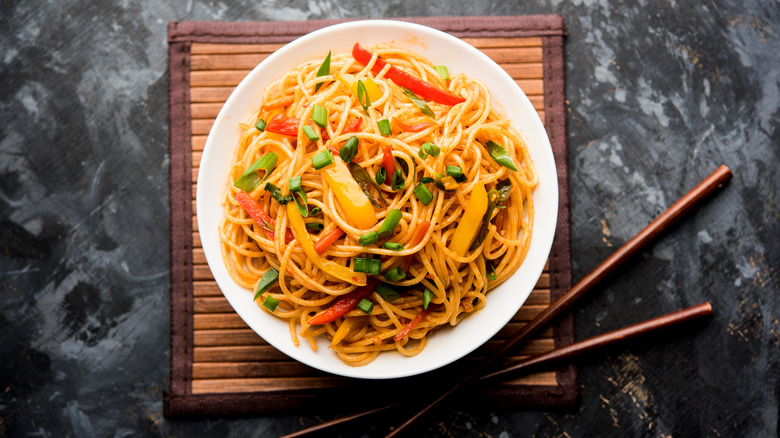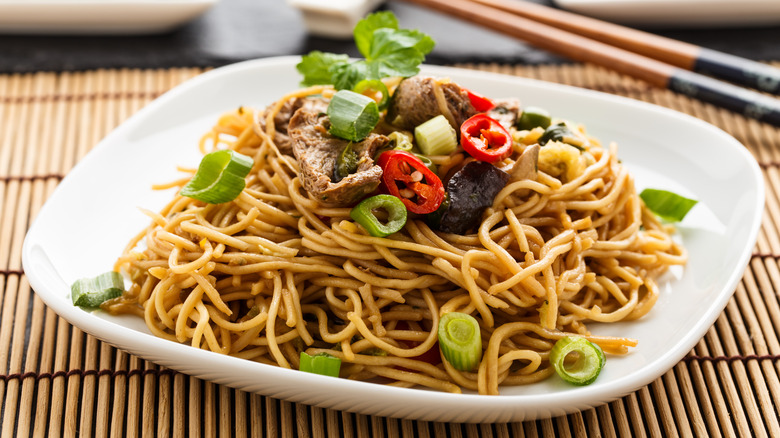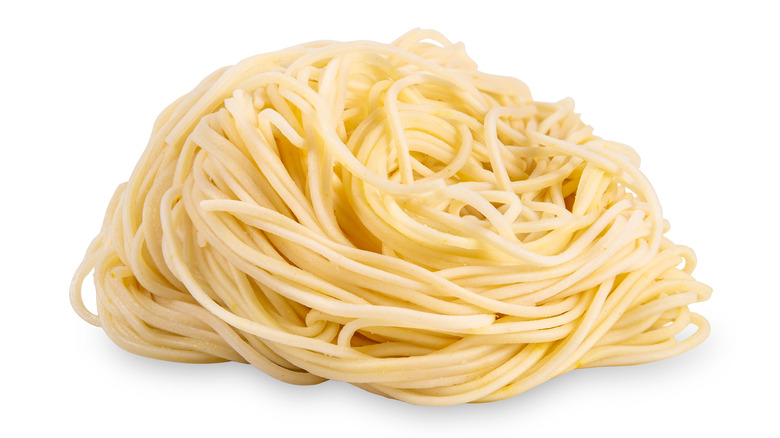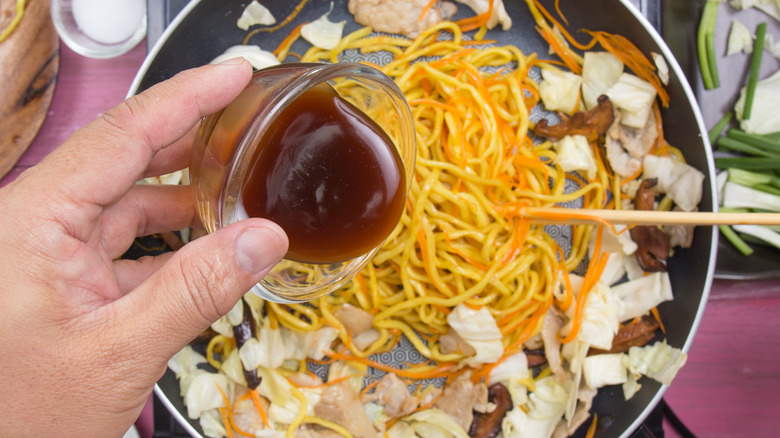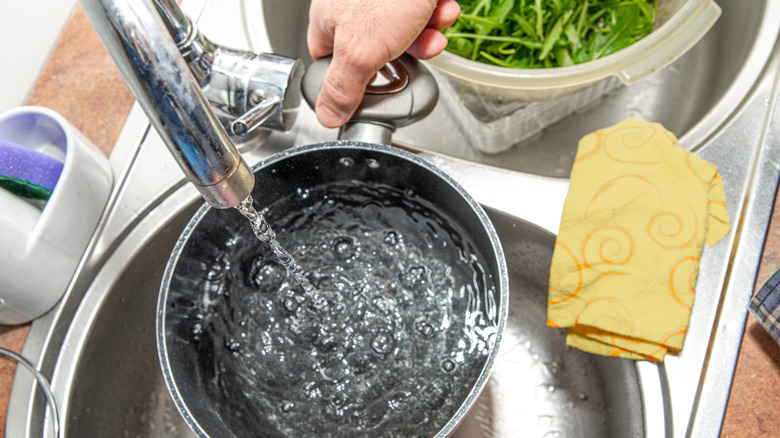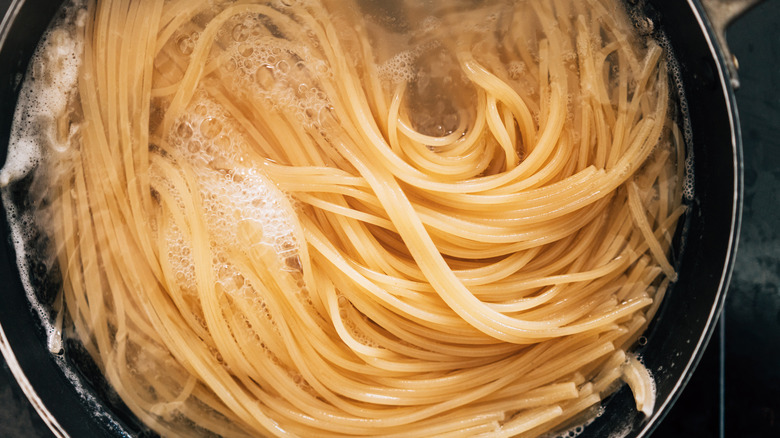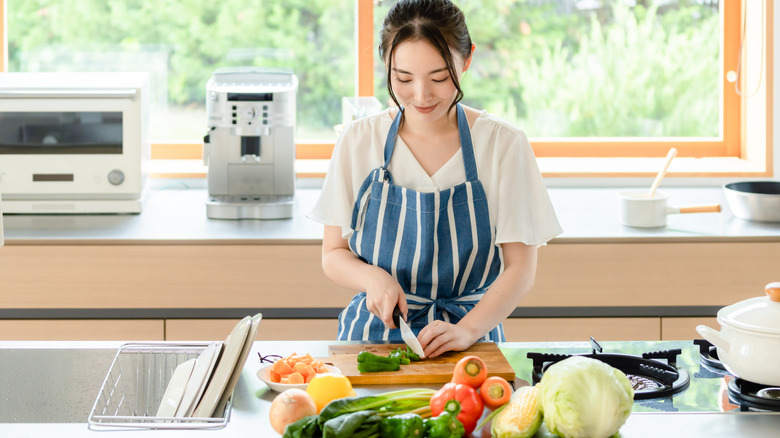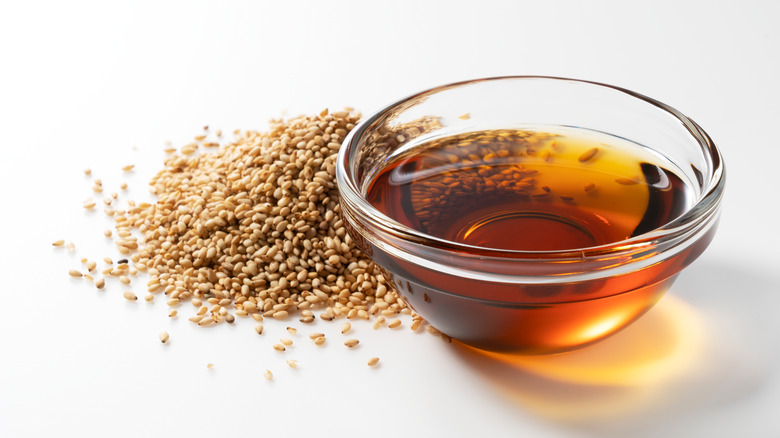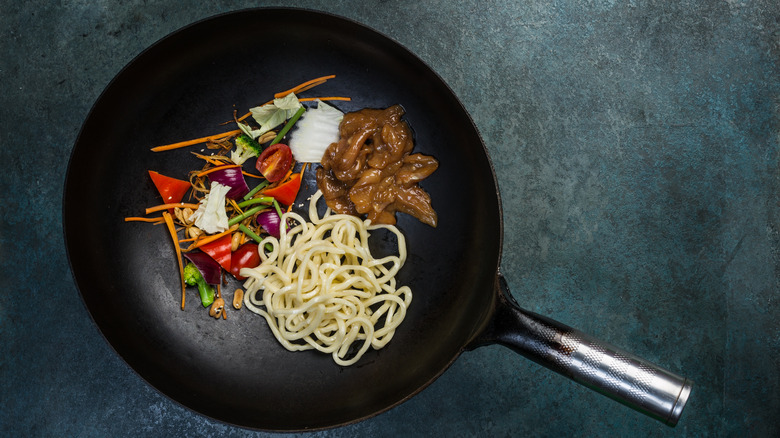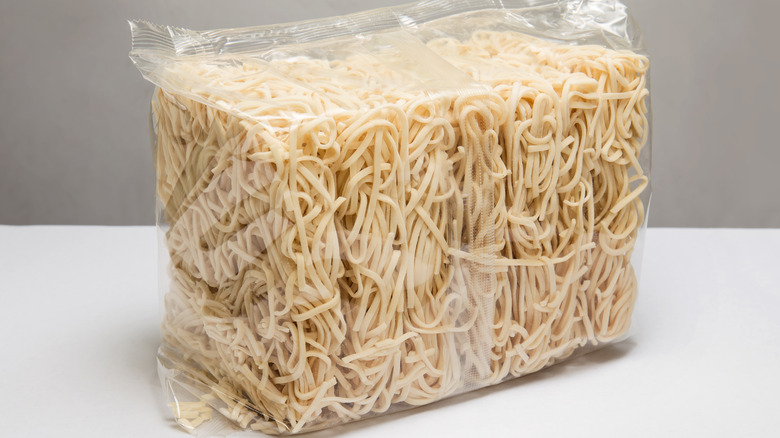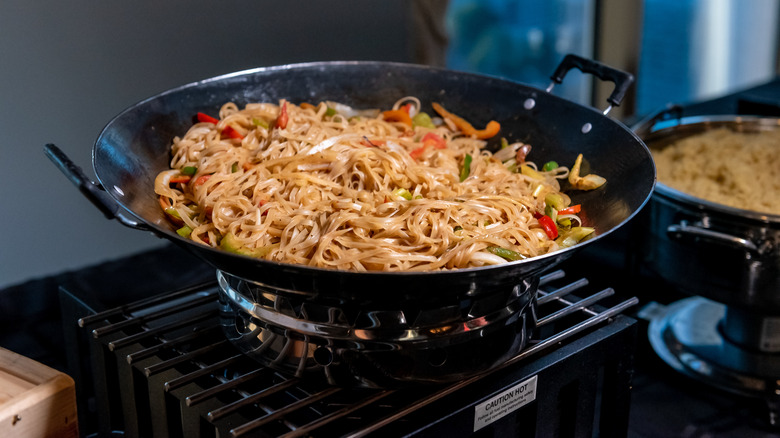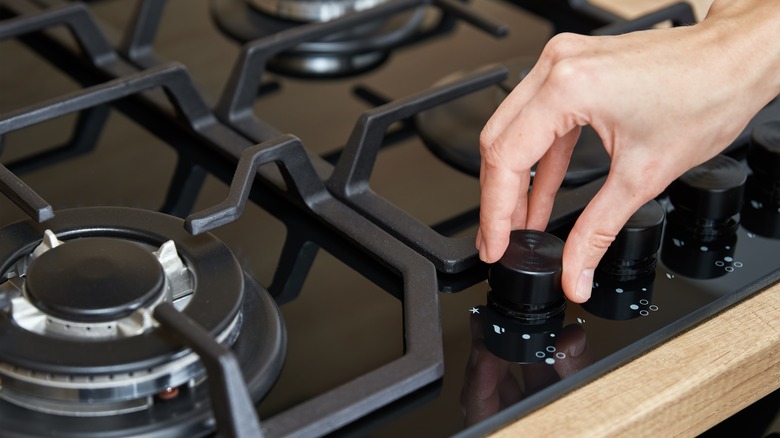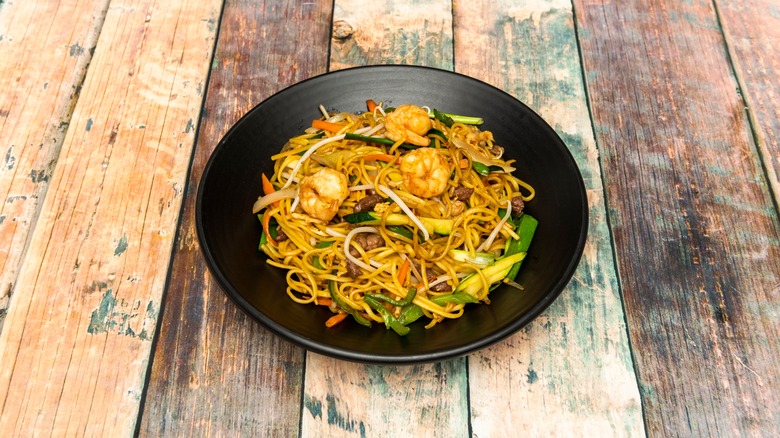Mistakes Everyone Makes With Chow Mein
Chinese immigrants have brought over many delicious meals to America, and we need to especially thank them for giving us a taste of chow mein. According to Taste Atlas, chow mein was first served in the United States at Chinese-American restaurants back in the 1850s.
This classic dish consists of noodles that are stir-fried along with the meat of your choice and topped with vegetables like cabbage, onions, or bean sprouts. The stir-fry isn't complete without its very own dressing, which needs soy sauce, sesame oil, red pepper flakes, and rice wine.
Chow mein, along with other traditional Chinese delicacies, has become popular and loved by Americans. The only downside to this fact is that it's become westernized, and many people are not only serving an unauthentic version but are making their chow mein incorrectly. If you want to make your chow mein instead of ordering take-out, try to avoid the many mistakes that can happen while cooking.
Confusing lo mein for chow mein
The most common mistake when it comes to cooking chow mein is accidentally making the recipe for lo mein instead. This is an immensely easy error to make as both dishes are stir-fried and include Asian egg noodles. Although chow mein and lo mein may seem like the same meal at first glance (and they are the same type of noodles), Food Network notes the essential difference is the technique used to prepare them.
All the ingredients of chow mein need to be cooked at the same time. Make sure to cook your noodles, vegetables, and meat together, or else you'll create the recipe for lo mein instead. Another key difference between these two dishes is that the noodles in chow mein are more crispy in comparison to lo mein. This is because you need to fry chow mein noodles until they are partly crispy. You can then add the meat and vegetables to stir-fry everything together. Once you've done these techniques, congratulations — you didn't make lo mein. (But if that's what you're into, we do have a great mapo Pork lo mein recipe.)
Using the wrong noodles
Rule number one when preparing any dish with noodles is to ensure you've purchased (or made) the correct kind of noodles for that recipe. Using the wrong noodles will result in the formation of a meal you didn't intend to assemble. For example, if you use rice noodles instead of egg noodles, you'll end up making chow fun instead of chow mein. Honest Food Talks describes the differences between chow mein noodles and chow fun (rice) noodles.
Rice noodles are thick and white, while Asian egg noodles are thin and yellow in appearance. Chow mein noodles are also said to bear some resemblance to Italian pasta. That said, you can make a quick substitution by using spaghetti to produce chow mein if you don't have access to Asian egg noodles. However, spaghetti isn't as effective for stir-frying and doesn't have the flavor and texture that makes chow mein so special. Staying true to the recipe not only respects Chinese culture but will also respect everyone's taste buds.
Making the wrong sauce
Chow mein is constantly confused with many other Chinese foods commonly served in America. Chop suey is one of many meals that fall into this category of mistaken identity. Both courses are accompanied by some kind of meat and a mix of veggies. Both sauces also have exceedingly similar ingredients, which include soy sauce, oyster sauce, corn flour (or starch), and Chinese cooking wine.
However, despite their similarities, Oriental Mart says the sauce is specifically what separates the dishes. The dressing for chow mein needs to have a thin consistency, while the sauce used for chop suey is thick — both in appearance and with its gravy-like texture, thickened by corn starch or a corn starch substitute. The first step in making the right sauce to go with your chow mein is to avoid the use of water. Another great way to differentiate your chow mein sauce from the one you might use for chop suey is to add sesame oil and sugar to your list of ingredients. The sugar will give your chow mein sauce a sweeter taste than chop suey, which is often served with an extra salty sauce. Similarly, the sesame oil adds a nutty, grain-like flavor accent.
Not using the right amount of water
What many home cooks might be unaware of is that you can cook chow mein in two different ways. Yum of China says you have the option to either prepare chow mein wet or dry. Wet refers to boiled noodles, while dry means deep-fried noodles. There's one key ingredient that indicates which version of chow mein will end up on your plate — water.
As long as you intend to make wet chow mein, you must use more water than you normally would. This is so the noodles won't get stuck together and become more difficult to cook properly. The additional water will also help keep the noodles and meat separated, making the stir-frying process more convenient. Not using enough water will result in dry chow mein. If you'd rather eat dry or crispy chow mein, simply refrain from adding more water and boil the noodles until they're nice and tender. Doing so will help the noodles become more sturdy by the time you're ready to begin stir-frying.
Adding too much water to cook dry chow mein will make the noodles too soft and prone to deforming. It's important to ensure you're using the right technique based on which type of chow mein you and those sitting at the dinner table prefer most.
Boiling noodles incorrectly
Cooking your noodles incorrectly is a perfect example of how making a single mistake can entirely reduce the quality of chow mein. Boiling is one of the most important processes in cooking chow mein, as much as it is in any dish involving noodles. It's a common misconception and one of the biggest mistakes you need to avoid with pasta; adding noodles to boiling water once you see a bunch of small bubbles appearing at the bottom of your pot is a big error. Small bubbles indicate that the water is close to boiling, but it's not there yet. So, when you add the chow mein noodles, they relax in warm water like a hot tub. The noodles will also become curdy and develop a sticky texture. Similarly, boiling too much water can also prime your noodles for a starch bath.
The way to avoid having that uncomfortable eating experience is simple — let your water have enough time to boil on its own. The purpose of boiling in the first place is to have the water hot enough for cooking. Placing noodles in your pot too early will prohibit the water from heating, as the noodles lower the temperature. Without boiled noodles, there is no chow mein; without chow mein, you'll most likely have to spend more money than you need by purchasing the dish at your local Chinese restaurant. Supporting your local spot is normally money well spent, except when you're there because you turned your noodles into gum.
Not preparing ingredients before cooking
Chow mein, along with many other stir-fry dishes, require a fast hand to serve them at high quality. Well Plated demonstrates techniques you can use to keep you from cooking too slow or rushing.
Make sure you have everything you need to put together your chow mein before stir-frying. Your meat needs to be cut in small quantities and vegetables chopped even smaller. Sauces and spices need to be measured in advance. You don't want to create a dish so bland you'd rather eat a bread roll, and you also don't want to get more flavor by using saltiness as a weapon against your tastebuds. Most importantly, everything needs to be in close range. Not having all the components near the stove can lead to rushing, resulting in a messy meal and kitchen.
When you are fully prepared to make chow mein, you no longer have to worry about any distractions that otherwise would lead to undercooked or overcooked noodles.
Forgetting to use oil
Oil is an essential component that every plate of chow mein needs. San-J explains that only a small amount of oil is necessary to fry noodles for the dish — making this an easy step to miss despite its importance. You won't be able to stir-fry chow mein noodles properly in a short amount of time without including oil.
Many chefs tend to prefer using peanut, soybean, or vegetable oil to make their delicious noodles. Peanut oil is especially known for its nutty and complex taste and is considered to be a top contender for stir-frying and deep frying. However, sesame oil is the type that's most often included in recipes for chow mein, especially when frying noodles and making the sauce. The mildly sweet, grain-like flavor adds nuanced layers to the finished dish.
WebMD explains that sesame oil is mostly used for sautéeing vegetables and meat, which is needed to make chow mein successfully. Sesame oil is also known for its many nutritional benefits, including protection from the sun, inflammation, and even stress. Canola oil is also beneficial when stir-frying noodles. However, it doesn't have a taste that is as flavorful as peanut oil. Any oil you choose will help keep the noodles from sticking together and enhance the quality of your completed chow mein.
Not using a wok
Although it's not inherently wrong to use a frying pan to make chow mein, a curved wok, which is a kitchen essential for mastering Chinese cooking, is especially effective in cooking chow mein along with other kinds of stir-fries. WebstaurantStore explains that a wok has more efficient heat distribution than a pan because of its structure. Woks have a round bottom and high walls, which help prevent cold spots and cook food evenly across the entire surface area. Its shape is also useful for tossing ingredients included in a stir-fry as they have more of a chance to fall back into the wok because of the higher walls. Throwing food in a pan is more likely to cause an unnecessary mess in your kitchen, and fewer ingredients are included in the final results.
Any type of wok will get the job done better than a pan, but a carbon steel wok specifically will be best to cook chow mein. This is because it's the kind that is most likely to prevent food from sticking to the sides and help stir-fry fast and effectively. It's also important to note that if you're using an electric stove for cooking chow mein, be sure to use a flat-bottomed wok.
Incorrectly handling packaged noodles
There's no shame in using packaged noodles to make your chow mein — under one condition. You must never stir-fry the noodles directly after opening their package. Serious Eats explains what needs to be done with packaged noodles before cooking them in the wok (or pan).
Place the packaged chow mein noodles in your refrigerator and keep them there for no longer than a week or until you're ready to cook them. Once the plastic has been opened, you must cook the noodles within the first few days, or they'll go bad. Remembering to check the expiration date before purchasing and using the noodles is also crucial for producing chow mein that won't give you a stomachache by the end of the day. It would be best to pour the noodles into a large bowl after the package has been opened so you can separate them before cooking. It's common for noodle strands to get stuck or wrapped around each other. Keeping them that way will make stir-frying difficult as they cannot be cooked evenly.
Cooking too many noodles at once
Everyone is tempted to eat with their eyes from time to time. Some may say bigger is better, but that's not the case when cooking chow mein. The delicacy is best prepared one portion at a time. Yum of China says the noodles will become more crispy and flavorful this way. Cooking large servings of noodles will result in unbalanced tastes and unevenly stir-fried chow mein. The texture is important here, and going slow can ensure you get the right feel and flavor to your chow mein.
If you're going to cook all these oodles of noodles, you'll need to use larger chopsticks, spatulas, or other kitchen equipment that functions best for stir-frying. Although this workaround is effective, it will not guarantee that your chow mein will have the best flavor possible. Only small batch cooking can do that. Cooking smaller quantities of chow mein noodles gives each strand more opportunities to make contact with the wok (or pan). The fewer noodles cooked at a time, the more likely it will achieve that crispy texture that is ever-so-loved in stir-fry dishes.
Avoid this chow mein mistake by turning up the heat
Setting your stove to high heat might make you fear that you're overcooking food, but it's necessary to cook chow mein correctly. According to Cook's Illustrated, high heat and constant motion are two essential components to properly making stir-fry noodles. Low heat will not only delay the cooking process, but it could stop it altogether. It is similar to how the temperature of boiling water goes down when you add noodles to the mix. Without extra heat, the water can become colder to the point that the boiling process will pause — a hot and fast boil allows you to keep temperatures high enough for cooking even if you remove a pot from heat. Similarly, failing to keep the heat up when stir-frying will also cool things down, keeping you from the crisp texture you desire.
Your stove must remain on high heat during the entire duration of stir-frying chow mein; otherwise, the texture will suffer. Intense heat allows the noodles, meat, and vegetables to be cooked equally and evenly. Along with the high heat setting, constant stirring is also a key factor in preventing the noodles from sticking to the wok (or pan) and distributing heat widely across the entire cooking surface. Let things sit for too long, and you may have one textured side with all the others being undercooked.
Reheating leftover chow mein incorrectly
The microwave comes in handy for reheating the majority of your leftovers. This isn't the case for chow mein. If you are wondering how to reheat Chinese food, know that the microwave will cause noodles to appear and feel soggy — an unpleasant texture for your mouth. Tell your microwave to take a break and let your wok (or pan) get to work.
Set your stove to high heat to efficiently warm up your chow mein leftovers and add an oil of your choice to it. The best way to reheat chow mein is to do so separately, just like how you cook it for the first time. The noodles, vegetables, and meat will have their flavors and textures as consistent as it was before. Using a wok (or pan) can even char the ingredients as if they were freshly made right then. If you feel the reheated chow mein is lacking in the flavor department, try adding soy sauce to enhance it. If you use this technique, your friends and family won't suspect your chow mein was reheated.
